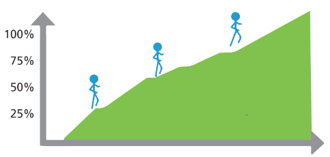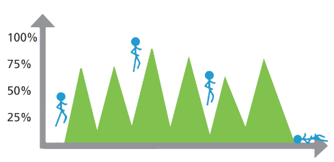25 Jan Load management and how to train smart
As we are now into the New Year period, athletes of all ages will be soon returning to training or sport after a well-earned break. While it is important to have a mental and physical rest from training, it is a good time to consider the topic of load management and its significance for injury prevention.
What is Load Management?
‘Load’ refers to any force placed on body tissues (bones, ligaments, tendons, muscles). This can be in various forms – anything from walking to the mailbox to playing a game of football.
‘Load management’ refers to the practice of controlling loads in order to reduce injury risk and maximise performance.
Body tissues need to be trained above a threshold to elicit positive training adaptations (becoming fitter, faster, and stronger) to maximise performance. Training load error occurs when training load is increased faster than the athlete’s body can adapt. This can lead to overuse-type injuries. On the other hand, too little training can leave you under-prepared for the physical demands of your chosen sport and creates increased susceptibility to injury.
Is load management only important in sport?
Have you ever been on a coastal holiday and walked double as much as you normally would (usually on a soft sandy surface), only to find you develop hip, knee or ankle/foot pain? This is also considered a ‘loading error’ – completing an activity in which the load demands on the body exceed its physical capacity to effectively cope with the load. This concept is not unique to sport.
How can I prevent training load error over the New Year holiday period?
Follow these three steps:
1 Follow the Goldilocks Principle (a)– if during 24-48 hours after exercise:
- No soreness (TOO COLD)
- do more next time
- Sore but eased (JUST RIGHT)
- stick at this
- Still sore (TOO HOT)
- do less next time
2 Complete a gradual and safe build-up of exercise (b)
 3 Avoid varied and rapid increases in exercise (c)
3 Avoid varied and rapid increases in exercise (c)
What about if I train many times per week? Am I at increased risk?
High training load is a protective factor for reducing injury risk. It helps by developing physical fitness and physical & mental resilience. The issue is how you get there. If you slowly and steadily increase your training loads over numerous months, you will minimise your risk of injury while eventually attaining high training loads. Alternatively, by accelerating your training progressions too quickly, you are more likely to encounter training load error and therefore increase your risk of injury.
Does loading error explain all injuries?
No. Establishing injury risk is complex and there is considerable individual variability among athletes and their ability to tolerate training load. This problem is often highlighted in team sports, where it is difficult to cater for individual training needs. As can be seen below, there are numerous risk factors for injury.
Modifiable risk factors
- Fitness
- Strength
- Flexibility
- Joint range-of-motion
Non-modifiable factors
- Age
- Genetics
- Injury and medical history
Non-physical (psycho-social) factors
- Emotional stressors
- Lifestyle stressors
- Sleep
The multitude of factors outlined above highlights that load management is only one piece of the injury puzzle.
I doubled my training load last week but I didn’t get injured. Why?
It is important to clarify that ‘risk does not equal rate’. Load management addresses risk of injuries. This is NOT the same as saying rate of injuries. Some people can cope unscathed despite obvious training load error, while injury can still occur even without obvious training load error. This is due to the numerous individual factors outlined above. While load management is an important consideration, it is not the ONLY culprit for injuries!
Our Physio’s in Glen Iris and Malvern East are skilled in injury prevention and load management. You can book HERE to get a tailored advice to your situation.
References/Acknowledgements:
a. Adam Meakins, Sports Physiotherapist
b,c. Dr. Christian Barton, Complete Sports Care


